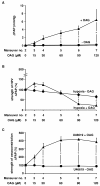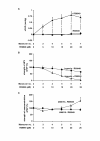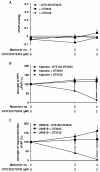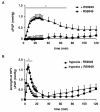Diacylglycerol regulates acute hypoxic pulmonary vasoconstriction via TRPC6
- PMID: 21294865
- PMCID: PMC3042943
- DOI: 10.1186/1465-9921-12-20
Diacylglycerol regulates acute hypoxic pulmonary vasoconstriction via TRPC6
Abstract
Background: Hypoxic pulmonary vasoconstriction (HPV) is an essential mechanism of the lung that matches blood perfusion to alveolar ventilation to optimize gas exchange. Recently we have demonstrated that acute but not sustained HPV is critically dependent on the classical transient receptor potential 6 (TRPC6) channel. However, the mechanism of TRPC6 activation during acute HPV remains elusive. We hypothesize that a diacylglycerol (DAG)-dependent activation of TRPC6 regulates acute HPV.
Methods: We investigated the effect of the DAG analog 1-oleoyl-2-acetyl-sn-glycerol (OAG) on normoxic vascular tone in isolated perfused and ventilated mouse lungs from TRPC6-deficient and wild-type mice. Moreover, the effects of OAG, the DAG kinase inhibitor R59949 and the phospholipase C inhibitor U73122 on the strength of HPV were investigated compared to those on non-hypoxia-induced vasoconstriction elicited by the thromboxane mimeticum U46619.
Results: OAG increased normoxic vascular tone in lungs from wild-type mice, but not in lungs from TRPC6-deficient mice. Under conditions of repetitive hypoxic ventilation, OAG as well as R59949 dose-dependently attenuated the strength of acute HPV whereas U46619-induced vasoconstrictions were not reduced. Like OAG, R59949 mimicked HPV, since it induced a dose-dependent vasoconstriction during normoxic ventilation. In contrast, U73122, a blocker of DAG synthesis, inhibited acute HPV whereas U73343, the inactive form of U73122, had no effect on HPV.
Conclusion: These findings support the conclusion that the TRPC6-dependency of acute HPV is induced via DAG.
Figures





References
-
- McDaniel SS, Platoshyn O, Wang J, Yu Y, Sweeney M, Krick S, Rubin LJ, Yuan JX. Capacitative Ca(2+) entry in agonist-induced pulmonary vasoconstriction. Am J Physiol Lung Cell Mol Physiol. 2001;280:L870–L880. - PubMed
Publication types
MeSH terms
Substances
LinkOut - more resources
Full Text Sources

